Things to see
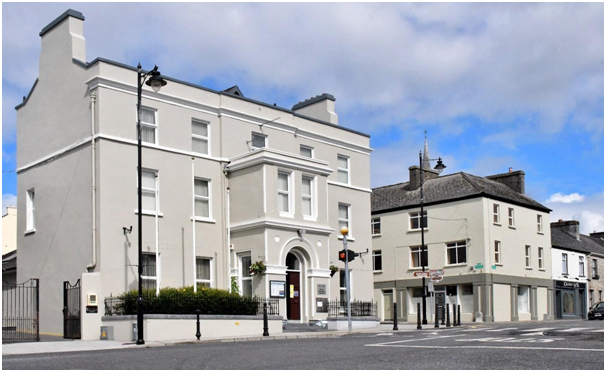
Dillon House
This is the former home of the Dillion Family (built c.1780), Not only a successful business family, but they were also accomplished parliamentarians. In 1814, John Blake Dillon, son of Luke Dillon was born in this house. John founded ‘The Nation’ newspaper along with Thomas Davis and Charles Gavan Duffy in 1842. This house was also home of John Blake Dillon, founder of the Young Irelanders and James Dillon, Leader of Fine Gael (1951 – 1963), also lived there. It was a meeting place for Eamon De Valera (1882 – 1975) dominant political figures in twentieth-century Ireland; Michael Davitt (1846 – 1906) Irish republican and nationalist agrarian agitator, Labour leader, journalist, Home Rule constitutional politician and Member of Parliament (MP) who founded the Irish National Land League; and Stewart Parnell (1846 – 1891) nationalist political leader, land reform agitator and the founder and leader of the Irish Parliamentary Party. Currently, the Western Development Commission and the Ballaghaderreen Branch of Roscommon County Library occupy the house.
The Cathedral
The Cathedral of the Annunciation of the Blessed Virgin Mary and St Nathy was commissioned by the Catholic Bishop of Achonry, which comprises parts of Counties Mayo, Roscommon and Sligo in 1855. The plan to build the Cathedral came from Bishop Patrick Durcan (1852 – 75). Nobody knows why he gave the commission to Weightman, Hadfield and Goldie of Sheffield in 1855. It is thought that Hadfield was probably the main architect involved in this commission because of his knowledge of the Irish architectural scene through his correspondence with Agustus Welby Pugin in 1849 – 50, who was the designer of Enniscorthy Cathedral and Killarney Cathedral. Within five years Ballaghaderreen had a Gothic church emulating medieval English and French models. The main builder was Mr. John Clarence of Ballisodare, Co. Sligo. The build was partly funded by land agent (Viscount Dillion estate) and main town planner Charles Strickland (c. 1818 – 1892) amongst others W.H. Byrne designed the Belfry and Tower, which was erected in 1912. The cathedral, noted for its beautiful and rare stain glass windows such as The Saint John and Saint Anne windows (1907) by Beatrice Elvery. Elvery was a member of An Túr Gloine [Tower of Glass] a cooperative studio for stained glass founded by Sarah Purser and Edward Martyn in 1903. They received the medieval art stained glass in Ireland and beyond. The way to follow the story of a stained-glass window is to read from bottom to top, rather than from left to right (as you would when reading a book).
The aisles have large two-light windows by Franz Mayer & Co. of Munich. The other large windows commemorate Charles Dillon (14th Viscount Dillion 1810 – 1865), and Charles Strickland (1818 -1892, local agent and town planner in County Mayo for Lord Dillion). These windows are in a small chapel on the south side of the sanctuary. Saint Nathy and Saint Bridget are among the subjects illustrated in the large 6-light east windows. Stained-glass windows were originally used to explain the stories of the Bible at a time when most people were unable to read and write. The story always begins with the image in the bottom of the left hand windowpane. Ballaghaderreen trade families such as Reid’s Gordon’s, Beirnes’s Gallagher’s, Flynn’s and Duffs – sponsored many of the windows in the cathedral.
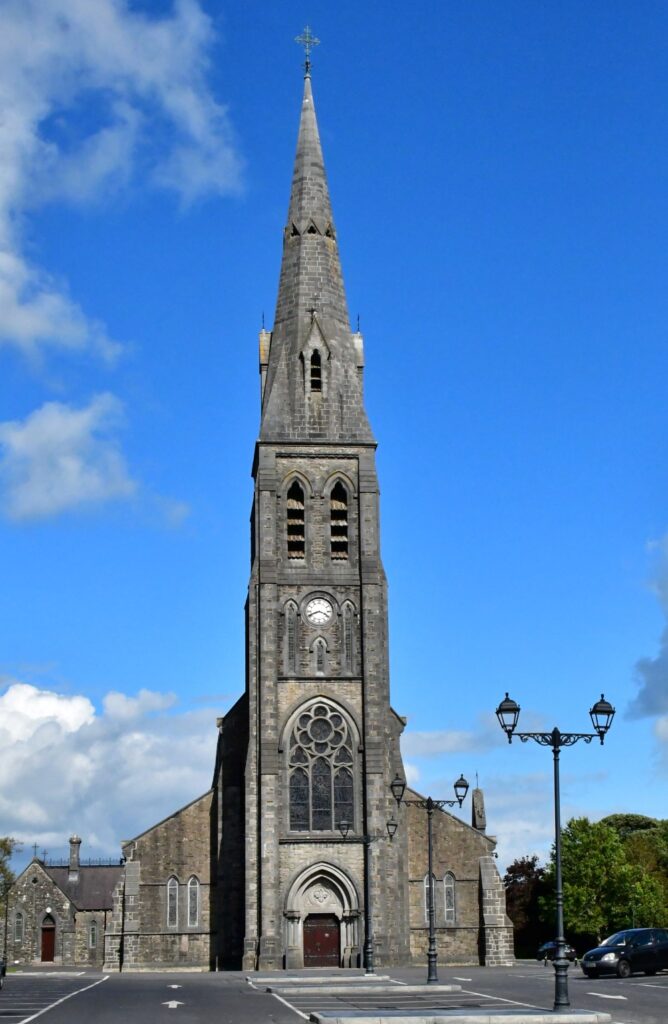

St Nathys College
St Nathy’s College formerly The Ballaghaderreen Military Barracks, has a possible build date of (c. 1830). The barracks was part funded and organized by the British Board of Ordnance (1414 – 1855) with assistance from local landlords – Barons de Freyne (Frenchpark) and Viscount Dillon (Loughglynn). Both families had held large tracts of land and property in Roscommon, Sligo, Galway and Meath (1622 – 1952). The Dillion’s (absentee landlords) owned the land on which the barracks was built. Between the years (1837 – 39), the barracks became the Centre of the Ordnance Survey. The Board of Ordnance was responsible for the management and distribution of all military supplies, builds and personnel both in Ireland and England. They also produced maps for military purposes. Many factors led to the construction of this and other barracks in the country.
In January 1896 St Nathy’s college opened upto male students. In 1996 the three existing secondary schools in the town amalgamated into one school. St Nathy’sCollege Today it is one of the oldest secondary school in the country.
Garden Quarter or Plots for the town
This expansive area was part of the Garden Quarters or the Plots for the town. The path (of which there are two other adjacent walkways) all lead to a circular meeting-point with a well. Mrs. Anne Deane (cousin of John Dillon) donated the well for the benefit of the townsfolk. There is a wildflower meadow behind the wall. This important habitat houses a diverse population of plants such as Horsetail, Yellow Flag Iris, Clover, Silverweed, Cow-parsley and Meadowsweet amongst others. The lands (north-east side of Market Square and south side of Pound Street) were divided up into triangles with pathways between, to allow each house to have its own plot linked by a precise radial pattern of footpaths which led to the circular well.


Edwardian Post Box
Edwardian post box, There is a very good example of an Edwardian Post Box to be found on Cathedral Street Introduced to Ireland in 1852 by Britain. They comprise of a range of designs and insignia, marker’s name relative to their time of production. This post box shows the initials ‘ER’. The box on Cathedral Street includes ‘ER’ with VII incorporated, meaning Edward Rex. This royal cypher is from the Edwardian period. Following Irish Independence in 1922, existing pillar-boxes remained but painted green. The post box on Cathedral Street carries the embossed initial ‘SE’ stamped on the door. A raised circular line headed by a harp surrounds the design. The initials ‘SE’ stand for SaorstátÈireann (1922 – 1937). This is the Irish Free State emblem, with the harp serving as the official emblem of Ireland. The harp represents the Trinity College harp thought to belong to Brian Boru (c. 941 – 1014).
St. Mary’s Chapel Graveyard
This small-enclosed rectangular graveyard houses two burial chambers. They have large, pitched slate roofs. Charles Strickland’s mother Ann who died in 1844 at Loughglynn house is buried in this vault amongst other family members. The Strickland family arrived in Ireland in 1814. The family descended from the Strickland’s, an old north of England catholic family connected by property and military services to Sizergh Castle, Cumbria. Jarrard Edward Strickland managed the Dillon Estate for 26 years. Charles obtained agency after his father’s death in 1844. Charles was also a Magistrate, a Grand-juror and justice of the peace. He died in 1892. Descendants of the Strickland family now live in Malta. Behind the first burial chamber is a free-standing stone cross. Absence of markings makes it impossible to determine its age, it may, however, suggest the earlier presence of an ecclesiastical foundation.
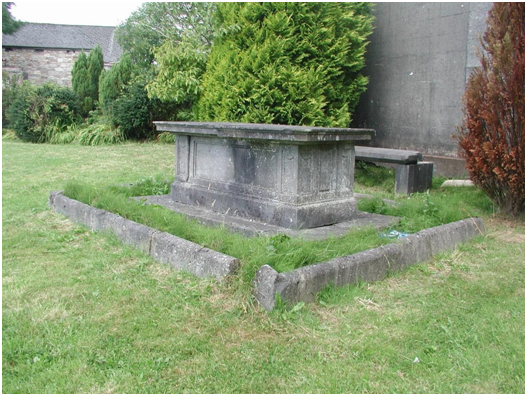
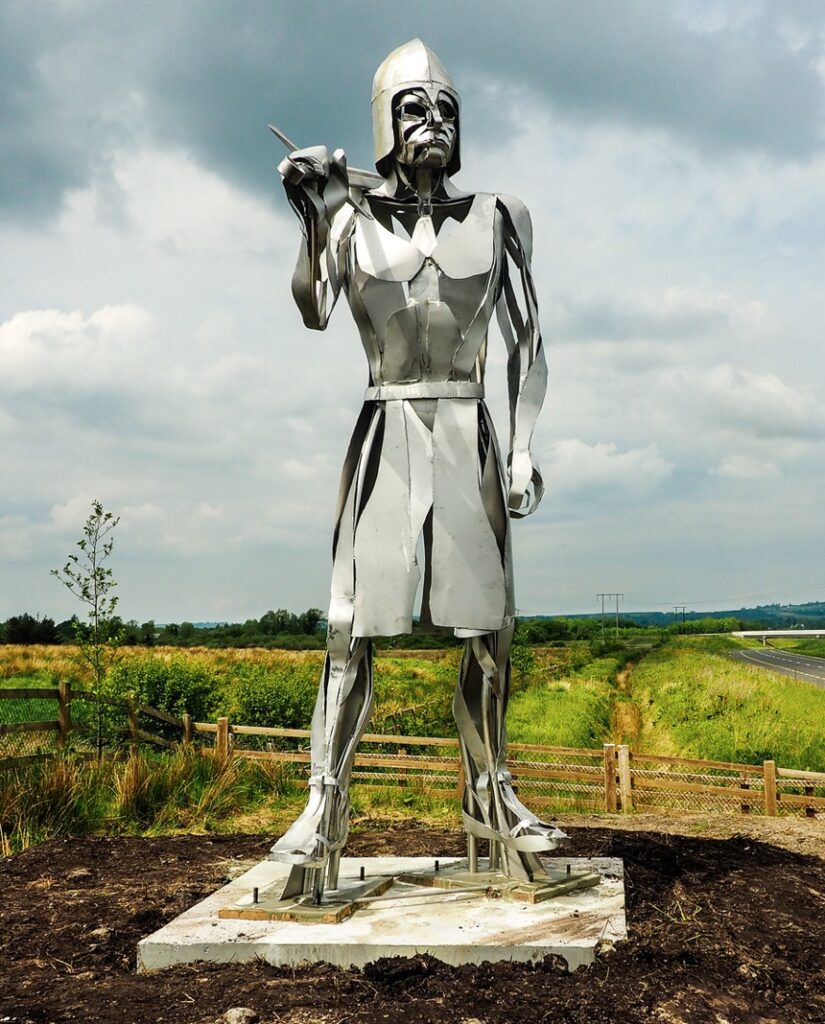
Unfortunately we do not advise parking along this road, as there is no designated parking so please enjoy the new symbol of Ballaghaderreen whilst passing or please drop into our welcoming town
The Gallowglass Warrior
A Gallowglass warrior takes pride of place on Ballaghaderreen bypass in Co. Roscommon, Connacht! The word Gallowglass is from Gallóglaigh (p. gal-ouge-lee, foreign soldiers). They were Gaelic speaking mercenary warriors who were brought over from Scotland to Ireland. The first historical mention of the Gallowglasses operating in Ireland is circa 1259 AD when Aedh Ó Chonchubhair a king in Connacht received a contingent of over 150 of these warriors as part of a dowry given by the king of the Hebrides, (hInnse Gaill ,or islands of the foreigners). When the Normans invaded Ireland their advance was stopped in 1270 AD, when Ó Conchubhair put his Gallowglasses to good use and slaughtered the Norman force near Carrick on Shannon.
When Edward Bruce came to claim Kingship of Ireland in 1315, he was accompanied by a great force of the Gallowglasses. The other Irish kings also started to hire in these fierce Scottish warriors who spoke their language and shared their customs. They would not only use them in their battles against the Norman English but also against each other. The Irish nobility inter-married with the Gael-gall and gave them lands and property throughout the island but particularly in Ulster. They were accepted and integrated completely with the native Irish at all levels including the nobility, especially within the northern half of the country but also in Munster and Connacht. It has been recorded that Gallowglass were in use as late as 1645 when McCarthyRiabhach used them in an assault on Mallow in County Cork.
Duff’s
The main building was the original trading premises for Monica Duff & Co. In 1812 the Dillon family moved to Ballaghaderreen. Thomas, his eldest son, started a shop, trading as Monica Duff & Co (Monica was the daughter of Luke Dillon). By the 1880’s, the firm had its own MONDUF brand label on almost every grocery and household product on the market and became one of the largest employers in Ballaghaderreen. It also housed the town’s Post Office. Renowned for its ‘MONDUF’ unsliced and unwrapped pan loaves. This bread had been the town’s favourite for more than 100 years. It closed its doors for the last time in 1986.
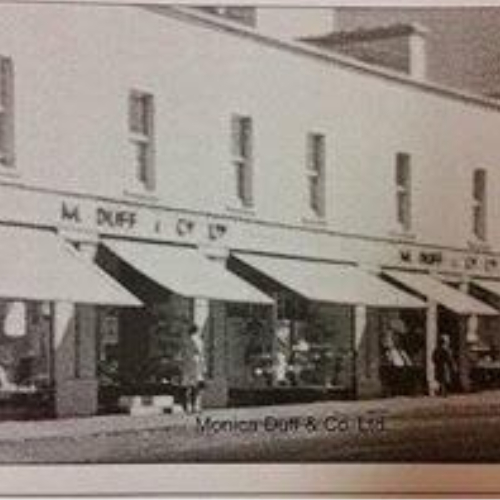

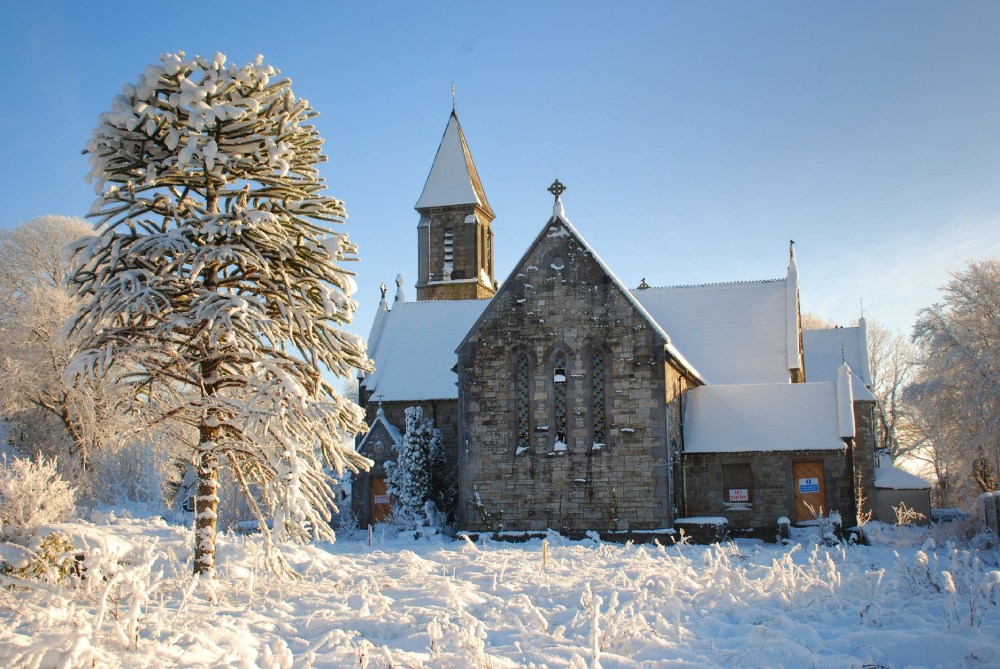
The Convent of Sisters of Charity
The Convent of Sisters of Charity, designed in a Gothic style complex by J.J. O’ Callaghan (c. 1876). In a state of disrepair, notable features include a large ornate rose window on the chapel wall. The main buildings that formed part of this complex no longer exist. The convent and chapel buildings and the gatehouse are all that remains. Friarshill Close a recent housing estate separates and splits the main ground of the complex. The nun’s graves (of which there were 19) moved to the burial site at the New Kilcolman Cemetery. The Sisters of Charity set up several enterprises such as a shirt and collar making industry, and laundry service. They also prepared for export harps and shamrock for St. Patrick’s Day. In 1886, they opened an ‘Industrial School’. Industrial Schools, (Irish: Scoileanna Saothair) were established in Ireland under the Industrial Schools Act of 1868 to care for “neglected, orphaned and abandoned children”. By 1884, there were 5,049 children in such institutions throughout the country. Unfortunately, the history of many industrial schools housed systemic abuse and torture of children. The Sisters of Charity left the town in 1969 replaced by the Sisters of Mercy. The Convent is in private ownership currently.
The Four Altars
The Four Altars, a ruin of penal times is situated about 5km from Ballaghaderreen town centre on the main Sligo Road. You will see it on your right-hand side in a field outside of Ballaghaderreen town. This monument was used in Ireland at a time when Catholicism was banned in the country under the Penal laws of the late 17th and early 18th centuries. These laws forced Catholics to practice in secret resulting in monuments such as the Four Altars. It was built by the Costellos of Cregan-na-Grant. It was constructed on a hill so the priest could see approaching English soldiers and he could flee to avoid being arrested. There are four alcoves, each containing an altar. The four altars face north, south, east and west so the priest was able to get shelter from the prevailing wind and rain when saying mass.

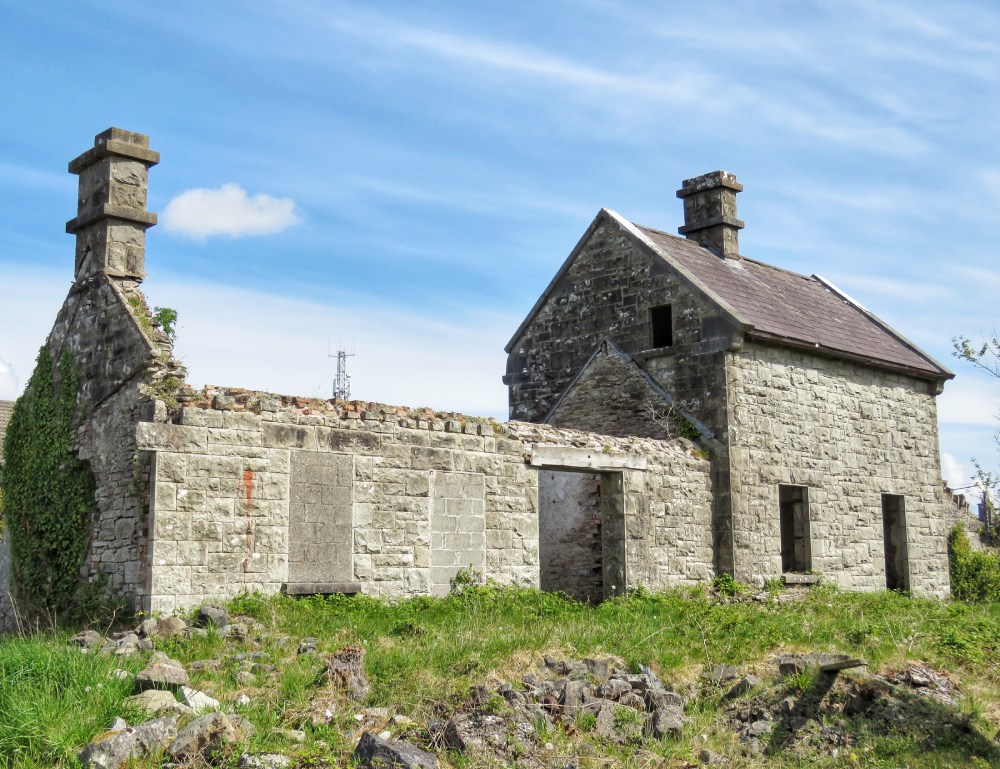
Sligo and Ballaghaderreen Junction Railway
In 1862 the Sligo and Ballaghaderreen Junction Railway was established with the intention of building a railway line from Killfree junction to Ballaghaderreen, connecting the town with the Longford to Sligo train line. In 1862, the ‘Bill application’ was presented and agreed to by Westminster. Insufficient share capital amongst other problems prevented the project in going ahead. In 1869, Strickland, Viscount Dillon and members of Sligo Corporation raised the necessary fifty thousand pounds. The Ballaghaderreen Terminus opened in 1874. The company ran at a loss, resulted in a take-over by the North Western and Great Union of Ireland Railway Company. The first engine to work the branch was the ‘Wren’ built in 1854, driven by Ben Partridge (father of William Partridge). Agricultural produce was the main traffic carried on these lines with local business flourishing. The Railway Terminus Station – a Victorian style ticket office is all that remains of this once great enterprise. It closed for business on Saturday 2nd February 1963. The railway tracks have all but disappeared since then, including the Station Masters house. The Goods Store, located further up from the terminus converted to a dance hall in the later sixties.
The Power House
The ‘Power House’ or (Electric Generating Station) supplied electricity and lights to Ballaghaderreen from (1906-7). Electricity generated by two suction Gas Engines ran on Welsh Anthracite. Due to the increase of population and trade in the town, waterpower replaced the anthracite, Energy was harnessed from the Lung River. The first Water Turbine installed (1912-13), with a later addition of a new turbine controlled from the Power House by a two-way electric motor. The Power House continued to operate well until 1933. The arrival of the E.S.B ended this unique operation lasting over a century. In recent times this building functioned as a science lab for the school, and later a museum and art centre.
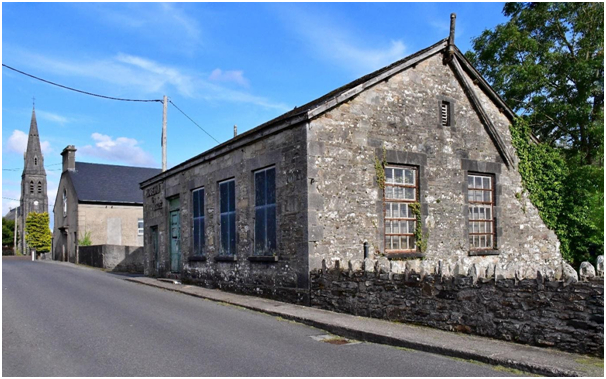
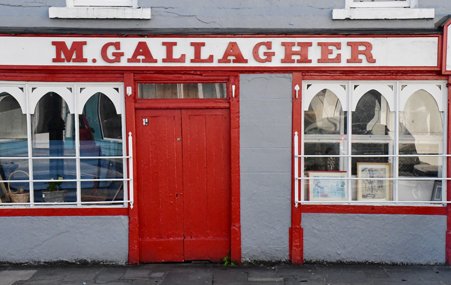
Gallagher’s
Gallaghers built by Michael Gallagher (c. 1830) served as both a butcher’s and publican house – the license of which remains in the Gallagher family. At the front of this building the original timber sash windows with stone sills and timber lettering, with scroll-shaped butcher brackets survive intact. Meat hung from these brackets before days of refrigeration. Inside the shop, there are small wooden barrels – containers from which whiskey was sold, drank and bottled. Gallaghers was then a clothes shop, run by Mary and Michael Gallagher. It was recorded that at one time, there were up to 40 to 50 licensed premises in Ballaghaderreen. Some of the pubs held fair-day licenses. This meant that they could open early in the morning on fair days. It was very usual for publican houses or pubs to have another business in their premises. Many pubs carried groceries and dry goods; others operated as hardware stores. One such example can be found further up on Main Street on the same side of Gallagher’s pub and hardware store J. Mulligans (c. 1944). There are now about 8 pubs operating in town.
The Tower House
The Tower House, in former times was the Rent Collectors Office for the Dillon’s. Other notable occupiers included William P. Partridge and his family. Market Street referred to a ‘Tea or Tay Street’. Trading merchants, such as Duff and Flannery’s gave bags of loose tea to people who lived on this street for them to pack into 1 lb. bags, to be sold in their shops. Opposite side of the Tower house is a wasteland site that fronts St. Nathy’s which is the original location of the old ‘Fair-green’. This space held open-air meetings, fairs and public celebrations such as May Day festivities. The Tower house is in private ownership currently.
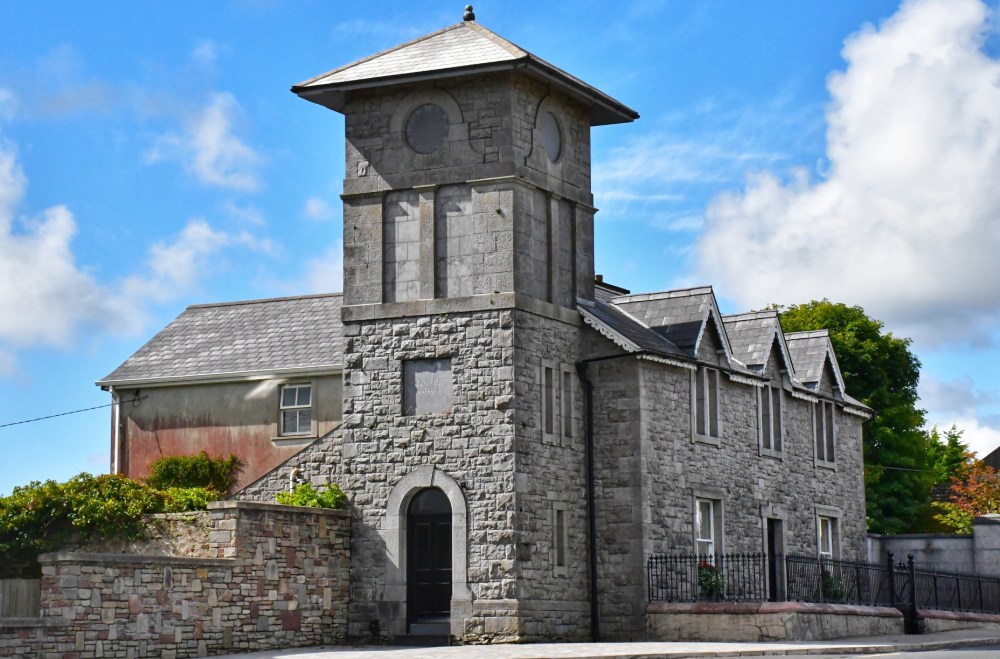
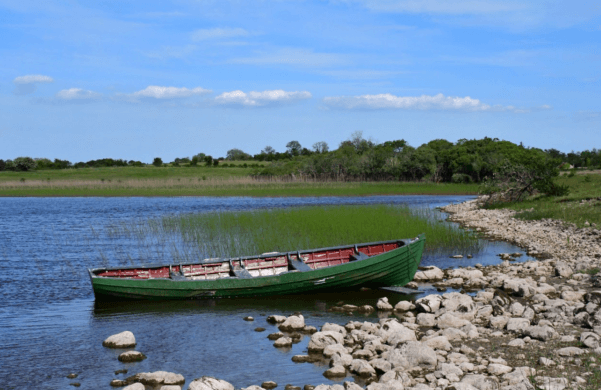
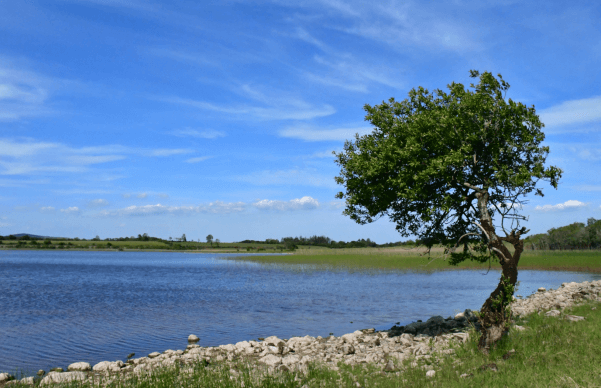
Lough Gara and its Crannogs
Lough Gara is only 4 miles east of Ballaghaderreen town. Lough Gara was known in ancient times as Loch Techet, but the O’Garas, during their ownership of the Coolavin district from about the thirteenth century, renamed the lake “Loch Uí Ghadhra”. The first documented reference appeared in 1285. Even though the family lost control of all their Coolavin townlands about 1650, their name has remained on the lake to the present day. The area around Lough Gara is referred to as “O’Gara heartland”.
Lough Gara is famed for having a high number of crannógs or ancient habitations on its shores and is perhaps one of Ireland’s best kept secrets. These crannogs were discovered in 1952 when drainage work was carried out on the lake. The word crannóg comes from the Irish words, crann, meaning tree, and óg, meaning young or, more accurately, small woods. There are various estimates of the actual number of crannógs on Lough Gara, with numbers ranging from 145-369. Crannógs are man-made islands mainly used as a defensive refuge or stronghold. It is thought they were occupied by various social classes with them being used as royal residences, ecclesiastical settlements and also serving as craft centres. In Ireland, crannógs were used in the Late Bronze Age, all the way through to the Middle Ages. The crannógs at Lough Gara date from the Late Bronze Age to the Early Iron Age making them over 2000 years old. The lake and nearby rivers are rich in votive offerings with many artefacts recovered. Several of the crannógs have been excavated. At one of the sites bracelets made of solid tin dating to the Bronze Age were found, this was a very valuable alloy at that time. The remains of 31 dug-out canoes which were used to access the crannógs were found at the bottom of the lake. When these wooden boats were discarded, they found their way into the material used to build many of Lough Garas crannógs. Evidence of Iron Age activity comes in the discovery of a bog body buried beside the lake in Derrymaquirk townland, the body was that of a woman aged 25 years. The body was radiocarbon dated to the Iron Age between 750-200BC. Further evidence of Iron Age activity is from a La Tene sword that was found in the thatch of a cottage in the townland of Cashel, north of the lake.

